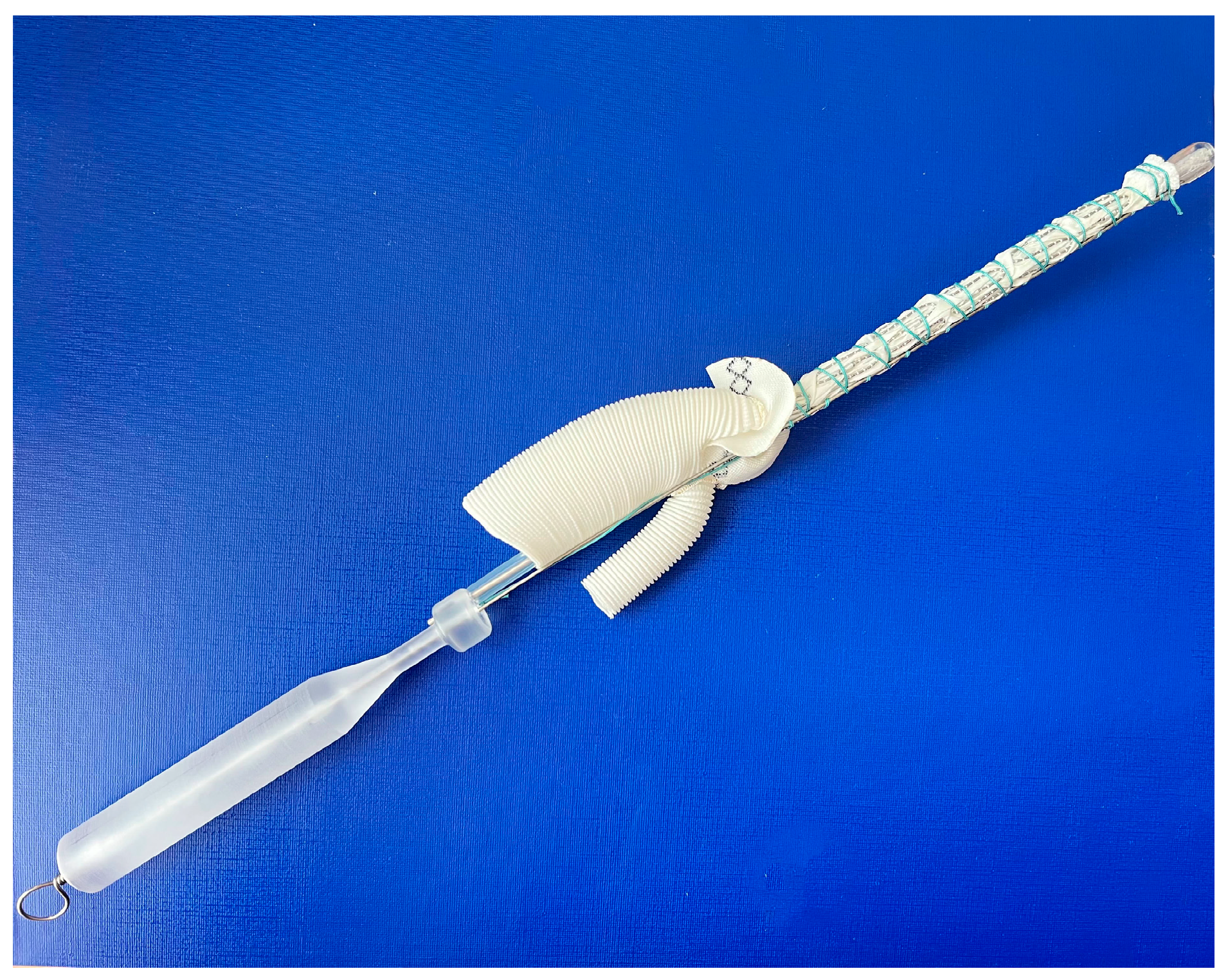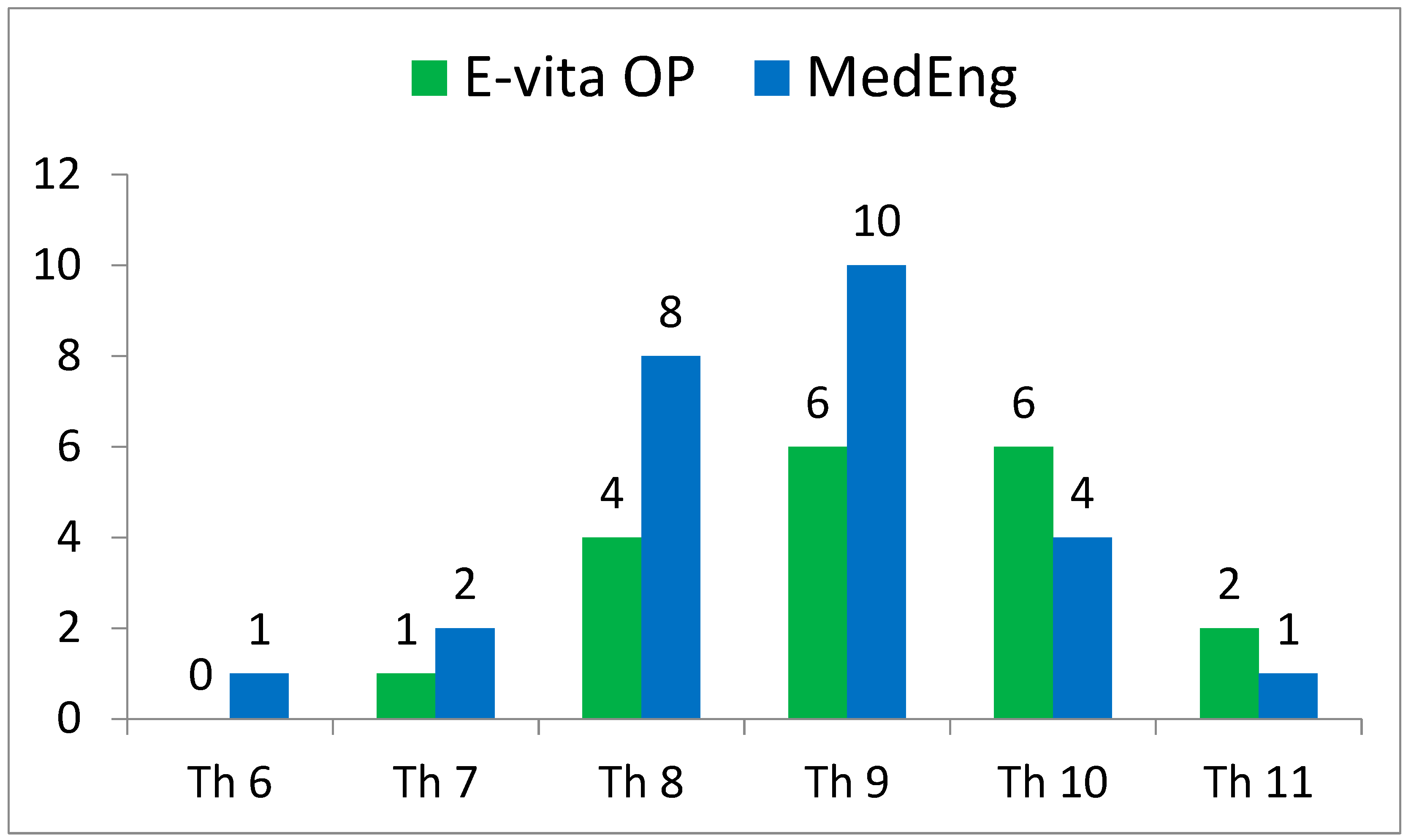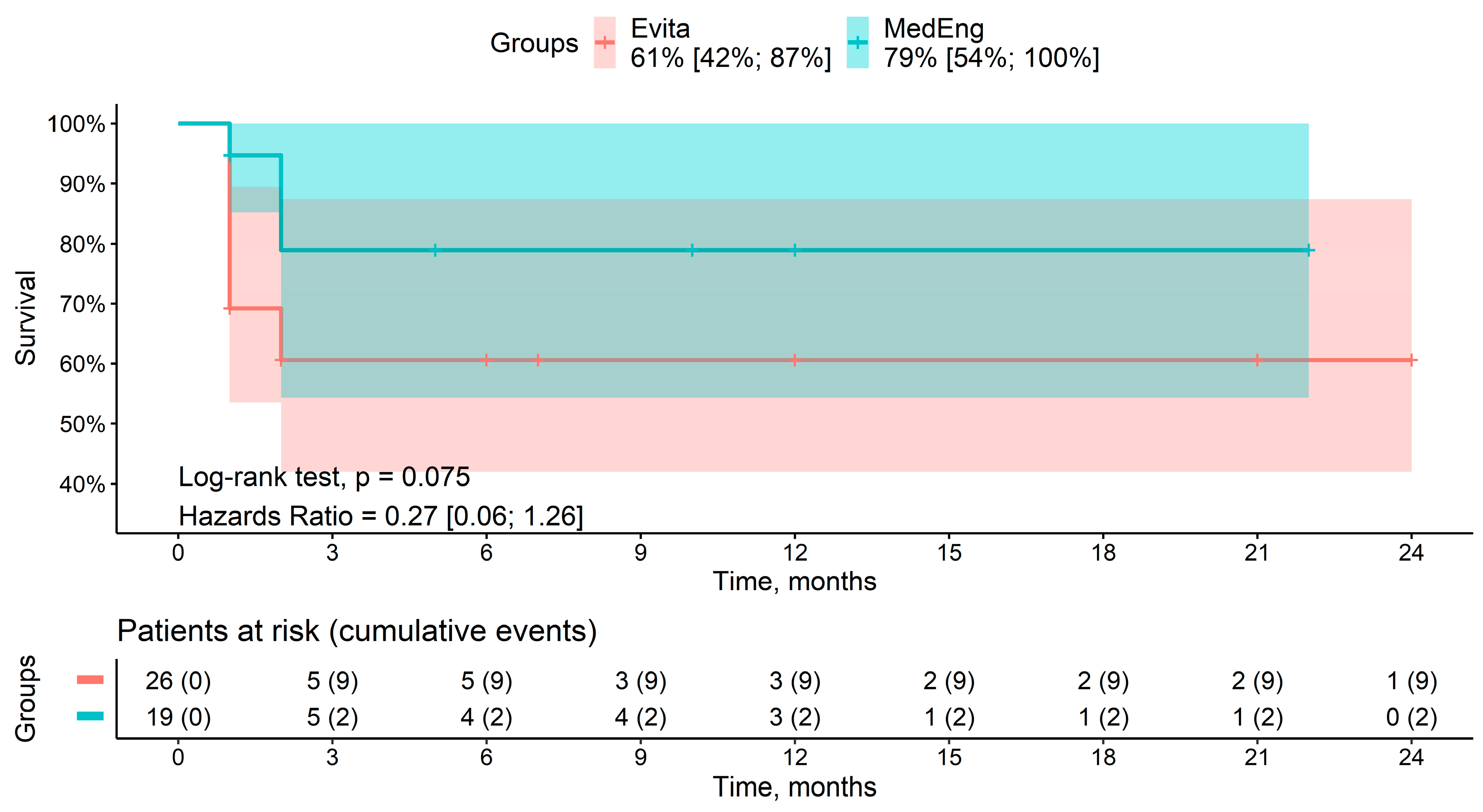Frozen Elephant Trunk for Aortic Dissection Using Different Hybrid Grafts: Preliminary Results from a Prospective Study
Abstract
1. Introduction
2. Materials and Methods
2.1. Image Analysis
2.2. Surgical Technique
2.3. Statistical Analysis
3. Results
3.1. Early Results
3.2. Mid-Term Results
3.3. Logistic Regression Analysis for Early Mortality
4. Discussion
Limitations and Strengths
5. Conclusions
Author Contributions
Funding
Institutional Review Board Statement
Informed Consent Statement
Data Availability Statement
Acknowledgments
Conflicts of Interest
References
- Bachet, J. Open repair techniques in the aortic arch are still superior. Ann. Cardiothorac. Surg. 2018, 7, 328–344. [Google Scholar] [CrossRef] [PubMed]
- Borst, H.G.; Walterbusch, G.; Schaps, D. Extensive aortic replacement using ‘elephant trunk’ prosthesis. Thorac. Cardiovasc. Surg. 1983, 31, 37–40. [Google Scholar] [CrossRef] [PubMed]
- Kato, M.; Ohnishi, K.; Kaneko, M.; Ueda, T.; Kishi, D.; Mizushima, T.; Matsuda, H. New graft-implanting method for thoracic aortic aneurysm or dissection with a stented graft. Circulation 1996, 94, 188–193. [Google Scholar]
- Karck, M.; Chavan, A.; Hagl, C.; Friedrich, H.; Galanski, M.; Haverich, A. The frozen elephant trunk technique: A new treatment for thoracic aortic aneurysms. J. Thorac. Cardiovasc. Surg. 2003, 125, 1550–1553. [Google Scholar] [CrossRef] [PubMed]
- Tian, D.H.; Wan, B.; Di Eusanio, M.; Black, D.; Yan, T.D. A systematic review and meta-analysis on the safety and efficacy of the frozen elephant trunk technique in aortic arch surgery. Ann. Cardiothorac. Surg. 2013, 2, 581–591. [Google Scholar] [CrossRef]
- Bossone, E.; Eagle, K.A. Epidemiology and management of aortic disease: Aortic aneurysms and acute aortic syndromes. Nat. Rev. Cardiol. 2021, 18, 331–348. [Google Scholar] [CrossRef] [PubMed]
- Shrestha, M.; Martens, A.; Kaufeld, T.; Beckmann, E.; Bertele, S.; Krueger, H.; Neuser, J.; Fleissner, F.; Ius, F.; Alhadi, F.A.; et al. Single-centre experience with the frozen elephant trunk technique in 251 patients over 15 years. Eur. J. Cardiothorac. Surg. 2017, 52, 858–866. [Google Scholar] [CrossRef]
- Leontyev, S.; Misfeld, M.; Daviewala, P.; Borger, M.A.; Etz, C.D.; Belaev, S.; Seeburger, J.; Holzhey, D.; Bakhtiary, F.; Mohr, F.W. Early- and medium-term results after aortic arch replacement with frozen elephant trunk techniques—A single center study. Ann. Cardiothorac. Surg. 2013, 2, 606–611. [Google Scholar] [CrossRef]
- Jakob, H.; Dohle, D.; Benedik, J.; Janosi, R.A.; Schlosser, T.; Wendt, D.; Thielmann, M.; Erbel, R.; Tsagakis, K. Long-term experience with the E-vita Open hybrid graft in complex thoracic aortic disease. Eur. J. Cardiothorac. Surg. 2017, 51, 329–338. [Google Scholar] [CrossRef]
- Tsagakis, K.; Jakob, H. Which Frozen Elephant Trunk offers the optimal solution? Reflections from Essen Group. Semin. Thorac. Cardiovasc. Surg. 2019, 31, 679–685. [Google Scholar] [CrossRef]
- Isselbacher, E.M.; Preventza, O.; Iii, J.H.B.; Augoustides, J.G.; Beck, A.W.; Bolen, M.A.; Braverman, A.C.; Bray, B.E.; Brown-Zimmerman, M.M.; Chen, E.P.; et al. 2022 ACC/AHA Guideline for the Diagnosis and Management of Aortic Disease: A Report of the American Heart Association/American College of Cardiology Joint Committee on Clinical Practice Guidelines. J. Am. Coll. Cardiol. 2022, 80, 223–393. [Google Scholar] [CrossRef]
- Ma, W.-G.; Zheng, J.; Sun, L.-Z.; Elefteriades, J.A. Open stented grafts for frozen elephant trunk technique: Technical aspects and current outcomes. Aorta 2015, 3, 122–135. [Google Scholar] [CrossRef]
- Berger, T.; Weiss, G.; Voetsch, A.; Arnold, Z.; Kreibich, M.; Rylski, B.; Krombholz-Reindl, P.; Winkler, A.; Mach, M.; Geisler, D.; et al. Multicentre experience with two frozen elephant trunk prostheses in the treatment of acute aortic dissection. Eur. J. Cardiothorac. Surg. 2019, 56, 572–578. [Google Scholar] [CrossRef]
- Tian, D.H.; Ha, H.; Joshi, Y.; Yan, T.D. Long-term outcomes of the frozen elephant trunk procedure: A systematic review. Ann. Cardiothorac. Surg. 2020, 9, 144–151. [Google Scholar] [CrossRef]
- Charchyan, E.; Breshenkov, D.; Belov, Y. Follow-up outcomes after the frozen elephant trunk technique in chronic type B dissection. Eur. J. Cardiothorac. Surg. 2020, 57, 904–911. [Google Scholar] [CrossRef]
- Leone, A.; Beckmann, E.; Martens, A.; Di Marco, L.; Pantaleo, A.; Reggiani, L.B.; Haverich, A.; Di Bartolomeo, R.; Pacini, D.; Shrestha, M. Total aortic arch replacement with frozen elephant trunk technique: Results from two European institutes. J. Thorac. Cardiovasc. Surg. 2020, 159, 1201–1211. [Google Scholar] [CrossRef]
- Verhoye, J.-P.; Belhaj Soulami, R.; Fouquet, O.; Ruggieri, V.G.; Kaladji, A.; Tomasi, J.; Tomasi, J.; Sellin, M.; Farhat, F.; Anselmi, A. Elective frozen elephant trunk procedure using the E-Vita Open Plus prosthesis in 94 patients: A multicentre French registry. Eur. J. Cardiothorac. Surg. 2017, 52, 733–739. [Google Scholar] [CrossRef]
- Wang, C.; Zhang, W.; Peng, J.; He, J.; Xu, W.; Chen, G.; Fan, X. Outcomes of long versus short stent cronus hybrid prosthesis in type A aortic dissection: A single centre experience. J. Card. Surg. 2021, 36, 3261–3268. [Google Scholar] [CrossRef]
- Panfilov, D.S.; Kozlov, B.N.; Pryakhin, A.S.; Kopeva, K.V. Frozen elephant trunk technique with different proximal landing zone for aortic dissection. Interdiscip. Cardiovasc. Thorac. Surg. 2021, 33, 286–292. [Google Scholar] [CrossRef]
- Okita, Y. Frozen elephant trunk with Frozenix prosthesis. Ann. Cardiothorac. Surg. 2020, 9, 152–163. [Google Scholar] [CrossRef]
- Shrestha, M.; Kaufeld, T.; Beckmann, E.; Fleissner, F.; Umminger, J.; Alhadi, F.A.; Boethig, D.; Krueger, H.; Haverich, A.; Martens, A. Total aortic arch replacement with a novel 4-branched frozen elephant trunk prosthesis: Single-center results of the first 100 patients. J. Thorac. Cardiovasc. Surg. 2016, 152, 148–159. [Google Scholar] [CrossRef] [PubMed]
- Ius, F.; Fleissner, F.; Pichlmaier, M.; Karck, M.; Martens, A.; Haverich, A.; Shrestha, M. Total aortic arch replacement with the frozen elephant trunk technique: 10-year follow-up single-centre experience. Eur. J. Cardiothorac. Surg. 2013, 44, 949–957. [Google Scholar] [CrossRef] [PubMed]
- Harky, A.; Fok, M.; Bashir, M. Which is the Optimal Frozen Elephant Trunk? A Systematic Review and Meta-Analysis of Outcomes in 2161 Patients Undergoing Thoracic Aortic Aneurysm Surgery Using E-vita OPEN PLUS Hybrid Stent Graft versus ThoraflexTM Hybrid Prosthesis. Braz. J. Cardiovasc. Surg. 2020, 35, 427–436. [Google Scholar] [CrossRef] [PubMed]
- Kozlov, B.N.; Panfilov, D.S.; Manvelyan, D.V.; Sonduev, E.L.; Zatolokin, V.V.; Petlin, K.A. The first results of surgical reconstruction of the aorta using the domestic aortic hybrid stent-graft MedEng. Sib. J. Clin. Exp. Med. 2021, 36, 101–107. [Google Scholar] [CrossRef]
- Choudhury, R.Y.; Basharat, K.; Zahra, S.A.; Tran, T.; Rimmer, L.; Harky, A.; Idhrees, M.; Bashir, M. “Proximalization is Advancement”—Zone 3 Frozen Elephant Trunk vs Zone 2 Frozen Elephant Trunk: A Literature Review. Vasc. Endovasc. Surg. 2021, 55, 612–618. [Google Scholar] [CrossRef]
- Tan, S.Z.C.P.; Lopuszko, A.; Munir, W.; Adams, B.; Bashir, M. Aortic proximalization—Zone 0 versus Zone 2: A concept or true challenge? J. Card. Surg. 2021, 36, 3319–3325. [Google Scholar] [CrossRef]
- Bisleri, G.; Hassan, S.M.A.; Payne, D.M.; Petsikas, D.; Hamilton, A.; Esposito, G. Zone 1 Debranching for Frozen Elephant Trunk and Whole-Body Perfusion. Innovations 2019, 14, 361–364. [Google Scholar] [CrossRef]
- Leone, A.; Di Marco, L.; Coppola, G.; Amodio, C.; Berardi, M.; Mariani, C.; Votano, D.; Reggiani, M.L.B.; Di Bartolomeo, R.; Pacini, D. Open distal anastomosis in the frozen elephant trunk technique: Initial experiences and preliminary results of arch zone 2 versus arch zone 3. Eur. J. Cardiothorac. Surg. 2019, 56, 564–571. [Google Scholar] [CrossRef]



| Variable | E-Vita OP (n = 19) | MedEng (n = 26) | Differences | p-Value |
|---|---|---|---|---|
| Height, cm | 171.89 ± 10.13 | 169.04 ± 7.23 | pseudo-MED (95%CI): −2 [−9; 3] SMD (95%CI): 0.33 [−0.28; 0.94] | 0.333 |
| Weight, kg | 77.95 ± 13.1 | 82.04 ± 17.87 | pseudo-MED (95%CI): 4 [−6; 12] SMD (95%CI): −0.26 [−0.86; 0.35] | 0.557 |
| BMI | 26.77 ± 3.87 | 28.43 ± 5.25 | pseudo-MED (95%CI): 1.29 [−2.19; 4.69] SMD (95%CI): −0.35 [−0.96; 0.25] | 0.509 |
| BSA | 1.9 ± 0.18 | 1.9 ± 0.2 | pseudo-MED (95%CI): 0.02 [−0.13; 0.14] SMD (95%CI): −0.02 [−0.67; 0.62] | 0.906 |
| Female sex, n (%) | 5 26% [12%; 49%] | 7 27% [14%; 46%] | RD: −1% [−27%; 26%] OR: 1 [0.2; 5] | >0.999 |
| Age, n (%) | 61.53 ± 9.23 | 58 ± 12.91 | pseudo-MED (95%CI): −2 [−9; 4] SMD (95%CI): 0.31 [−0.29; 0.9] | 0.534 |
| Acute AD, n (%) | 7 37% [19%; 59%] | 13 50% [32%; 68%] | RD: −13% [−42%; 16%] OR: 1.7 [0.4; 6.9] | 0.545 |
| Chronic AD, n (%) | 12 63% [41%; 81%] | 12 46% [29%; 65%] | RD: 17% [−12%; 46%] OR: 0.5 [0.1; 2] | 0.366 |
| Type A AD, n (%) | 9 47% [27%; 68%] | 11 42% [26%; 61%] | RD: 5% [−24%; 34%] OR: 0.8 [0.2; 3.2] | 0.770 |
| Type B AD, n (%) | 3 16% [6%; 38%] | 7 27% [14%; 46%] | RD: −11% [−35%; 13%] OR: 1.9 [0.4; 13.5] | 0.481 |
| Type nonA-nonB AD, n (%) | 1 5% [1%; 25%] | 5 19% [9%; 38%] | RD: −14% [−32%; 4%] OR: 4.2 [0.4; 213.5] | 0.222 |
| Redo cardiac surgery, n (%) | 1 5% [1%; 25%] | 2 8% [2%; 24%] | RD: 3% [1%; 10%] OR: 0 [0; 28.5] | 0.512 |
| Hypertension, n (%) | 16 84% [62%; 94%] | 24 92% [76%; 98%] | RD: −8% [−27%; 11%] OR: 2.2 [0.2; 29.2] | 0.636 |
| Type 2 diabetes mellitus, n (%) | 0 0% [0%; 17%] | 2 8% [2%; 24%] | - | 0.501 |
| COPD, n (%) | 1 5% [1%; 25%] | 3 12% [4%; 30%] | RD: −7% [−23%; 9%] OR: 2.4 [0.2; 135.8] | 0.622 |
| Atrial fibrillation, n (%) | 2 11% [3%; 31%] | 3 12% [4%; 29%] | RD: −1% [−19%; 17%] OR: 1.1 [0.1; 14.6] | >0.999 |
| History of stroke, n (%) | 0 | 2 8% [2%; 24%] | - | 0.501 |
| CAD, n (%) | 4 21% [9%; 43%] | 8 31% [17%; 50%] | RD: −10% [−35%; 16%] OR: 1.6 [0.4; 9] | 0.517 |
| Creatinine, n (%) | 104.06 ± 28.63 | 122.65 ± 103.44 | pseudo-MED (95%CI): −4 [−19; 20] SMD (95%CI): −0.23 [−0.87; 0.41] | 0.753 |
| LVEF, % | 65 [59.5; 65.5] | 64 [61; 66] | pseudo-MED (95%CI): 0 [−3; 3] SMD (95%CI): 0.04 [−0.56; 0.63] | 0.943 |
| Severe aortic insufficiency, n (%) | 1 5% [1%; 25%] | 5 19% [9%; 38%] | RD: −14% [−32%; 4%] OR: 4.2 [0.4; 213.5] | 0.222 |
| Variable | E-Vita OP (n = 19) | MedEng (n = 26) | Differences | p-Value |
|---|---|---|---|---|
| Duration of the surgery, min | 360 [300; 420] | 390 [305; 505] | pseudo-MED (95%CI): 40 [−20; 120] SMD (95%CI): −0.5 [−1.17; 0.16] | 0.196 |
| CPB time, min | 180 [165; 245] | 205 [175; 270] | pseudo-MED (95%CI): 25 [−5; 65] SMD (95%CI): −0.53 [−1.16; 0.09] | 0.112 |
| Cardiac arrest time, min | 144.5 [116.25; 198.75] | 150 [137; 220] | pseudo-MED (95%CI): 13 [−18; 44] SMD (95%CI): −0.22 [−0.83; 0.39] | 0.375 |
| Lower body circulatory arrest time, min | 28 [12; 34] | 30 [20; 35] | pseudo-MED (95%CI): 1 [−5; 8] SMD (95%CI): −0.14 [−0.74; 0.45] | 0.635 |
| Cerebral perfusion time, min | 67.5 [54.25; 78.75] | 63 [48.75; 78.5] | pseudo-MED (95%CI): −5 [−20; 9] SMD (95%CI): 0.21 [−0.4; 0.82] | 0.516 |
| Concomitant surgery | ||||
| CABG, n (%) | 3 16% [6%; 38%] | 5 19% [9%; 38%] | RD: −3% [−26%; 19%] OR: 1.3 [0.2; 9.4] | >0.999 |
| AVR, n (%) | 0 | 1 4% [1%; 19%] | - | >0.999 |
| Bentall procedure, n (%) | 4 21% [9%; 43%] | 3 12% [4%; 29%] | RD: 10% [−13%; 32%] OR: 0.5 [0.1; 3.4] | 0.433 |
| Proximal landing zone | ||||
| Zone 0, n (%) | 1 5% [1%; 25%] | 3 12% [4%; 29%] | RD: −6% [−22%; 10%] OR: 2.3 [0.2; 129.9] | 0.627 |
| Zone 1, n (%) | 1 5% [1%; 25%] | 1 4% [1%; 19%] | RD: 1% [−11%; 14%] OR: 0.7 [0; 59.6] | >0.999 |
| Zone 2, n (%) | 6 32% [15%; 54%] | 11 42% [26%; 61%] | RD: −11% [−39%; 18%] OR: 1.6 [0.4; 6.8] | 0.543 |
| Zone 3, n (%) | 11 58% [36%; 77%] | 11 42% [26%; 61%] | RD: 16% [−14%; 45%] OR: 0.5 [0.1; 2.1] | 0.373 |
| Supra-aortic vessel reconstruction | ||||
| Island technique, n (%) | 17 89% [69%; 97%] | 18 69% [50%; 83%] | RD: 20% [−2%; 43%] OR: 0.3 [0; 1.6] | 0.154 |
| Island technique with separate re-implantation of the LSA, n (%) | 6 32% [15%; 54%] | 8 31% [17%; 50%] | RD: 1% [−27%; 28%] OR: 1 [0.2; 4.3] | >0.999 |
| Separate re-implantation of the supra-aortic vessels, n (%) | 2 11% [3%; 31%] | 7 27% [14%; 46%] | RD: −16% [−38%; 6%] OR: 3.1 [0.5; 34.1] | 0.264 |
| Variable | E-Vita OP (n = 19) | MedEng (n = 26) | Differences | p-Value |
|---|---|---|---|---|
| ICU stay, days (range) | 17.59 ± 25.06 (1–83) | 8.33 ± 7.3 (1–34) | pseudo-MED (95%CI): 0 [−7; 4] SMD (95%CI): 0.53 [−0.12; 1.18] | 0.965 |
| Delirium, n (%) | 0 | 4 15% [6%; 34%] | - | 0.126 |
| Stroke, n (%) | 2 11% [3%; 31%] | 1 4% [1%; 19%] | RD: 7% [−9%; 22%] OR: 0.3 [0; 7.2] | 0.565 |
| Spinal cord ischemia, n (%) | 2 11% [3%; 31%] | 0 | RD: 11% [−3%; 24%] OR: 0 [0; 3.8] | 0.173 |
| Lung ventilation, hours (range) | 23 [17; 50] (6–1654) | 24.5 [16.75; 50.75] (4–831) | pseudo-MED (95%CI): 0.95 [−11; 10] SMD (95%CI): 0.5 [−0.14; 1.14] | 0.966 |
| Respiratory failure (tracheostomy), n (%) | 4 21% [9%; 43%] | 6 23% [11%; 42%] | RD: −2% [−26%; 22%] OR: 1.1 [0.2; 6.4] | >0.999 |
| Myocardial infarction, n (%) | 2 11% [3%; 31%] | 2 8% [2%; 24%] | RD: 3% [−14%; 20%] OR: 0.7 [0; 10.8] | >0.999 |
| Creatinine (24 h after surgery), mmol/L | 134 [101.25; 154.75] | 180.5 [116; 257] | pseudo-MED (95%CI): 40 [0; 106] SMD (95%CI): −0.77 [−1.44; −0.1] | 0.054 |
| AKI (dialysis), n (%) | 3 16% [6%; 38%] | 8 31% [17%; 50%] | RD: −15% [−39%; 9%] OR: 2.3 [0.5; 16] | 0.309 |
| MOF, n (%) | 2 11% [3%; 31%] | 6 23% [11%; 42%] | RD: −13% [−34%; 9%] OR: 2.5 [0.4; 28.5] | 0.435 |
| Blood loss, mL | 500 [300; 600] | 600 [500; 700] | pseudo-MED (95%CI): 100 [0; 300] SMD (95%CI): −0.57 [−1.22; 0.08] | 0.072 |
| Bleeding (re-sternotomy), n (%) | 0 | 4 15% [6%; 34%] | - | 0.126 |
| RBC transfusion, unit | 2 [1; 2] | 2 [2; 3] | - | 0.715 |
| FFP transfusion, unit | 3 [2; 3] | 3 [2; 4] | - | 0.441 |
| Platelet transfusion, unit | 2 [1; 2] | 2 [2; 3] | - | 0.888 |
| Deep/superficial wound complications, n (%) | 0 | 0 | - | >0.999 |
| 30-day mortality, n (%) | 0 | 2 8% [2%; 24%] | - | 0.501 |
Disclaimer/Publisher’s Note: The statements, opinions and data contained in all publications are solely those of the individual author(s) and contributor(s) and not of MDPI and/or the editor(s). MDPI and/or the editor(s) disclaim responsibility for any injury to people or property resulting from any ideas, methods, instructions or products referred to in the content. |
© 2023 by the authors. Licensee MDPI, Basel, Switzerland. This article is an open access article distributed under the terms and conditions of the Creative Commons Attribution (CC BY) license (https://creativecommons.org/licenses/by/4.0/).
Share and Cite
Kozlov, B.; Panfilov, D.; Lukinov, V. Frozen Elephant Trunk for Aortic Dissection Using Different Hybrid Grafts: Preliminary Results from a Prospective Study. J. Pers. Med. 2023, 13, 784. https://doi.org/10.3390/jpm13050784
Kozlov B, Panfilov D, Lukinov V. Frozen Elephant Trunk for Aortic Dissection Using Different Hybrid Grafts: Preliminary Results from a Prospective Study. Journal of Personalized Medicine. 2023; 13(5):784. https://doi.org/10.3390/jpm13050784
Chicago/Turabian StyleKozlov, Boris, Dmitri Panfilov, and Vitaliy Lukinov. 2023. "Frozen Elephant Trunk for Aortic Dissection Using Different Hybrid Grafts: Preliminary Results from a Prospective Study" Journal of Personalized Medicine 13, no. 5: 784. https://doi.org/10.3390/jpm13050784
APA StyleKozlov, B., Panfilov, D., & Lukinov, V. (2023). Frozen Elephant Trunk for Aortic Dissection Using Different Hybrid Grafts: Preliminary Results from a Prospective Study. Journal of Personalized Medicine, 13(5), 784. https://doi.org/10.3390/jpm13050784






